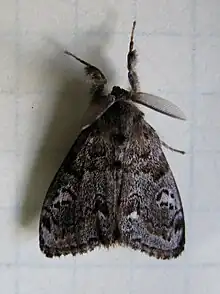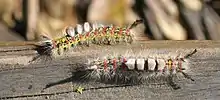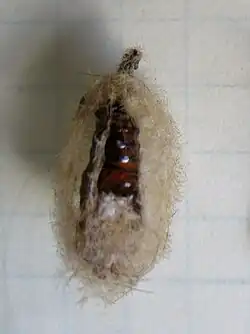| Western tussock moth | |
|---|---|
 | |
| Male | |
 | |
| Pair of mature caterpillars, early May | |
| Scientific classification | |
| Domain: | Eukaryota |
| Kingdom: | Animalia |
| Phylum: | Arthropoda |
| Class: | Insecta |
| Order: | Lepidoptera |
| Superfamily: | Noctuoidea |
| Family: | Erebidae |
| Genus: | Orgyia |
| Species: | O. vetusta |
| Binomial name | |
| Orgyia vetusta Boisduval, 1852 | |
The western tussock moth, Orgyia vetusta, formerly Hemerocampa vetusta, is a moth found in the Pacific States and British Columbia, as well as an isolated population in Boise County, Idaho. The species is dimorphic; the females are flightless. This species has also been seen in gulf coast states such as Louisiana.

Empty O. vetusta cocoon, the pupal exuvia is clearly visible
References
- USDA Forest Pest Leaflet 120
- University of California pest management guidelines for Apple, Apricot, Cherry, Citrus, Pistachio, Plum, and Prune
- Stanford University Grounds Services: Evaluating the Effectiveness of Releasing Beneficial Insects to Control Tussock Moth Populations at Stanford University
- Note to caterpillars dangling under the oaks: Meet the beetles
This article is issued from Wikipedia. The text is licensed under Creative Commons - Attribution - Sharealike. Additional terms may apply for the media files.